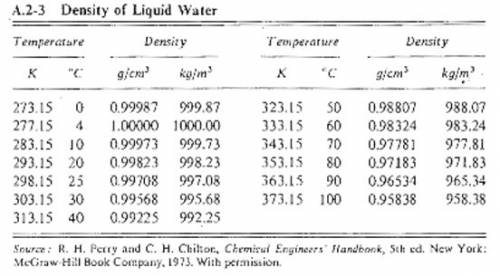
Suppose you were calibrating a 100.0 ml volumetric flask using distilled water. the flask temperature was at 20°c, and you assumed that the distilled water was as well. however, you later discover that the actual water temperature was 11°c instead. how is the mass of the 100.0 ml of distilled water you measured at 11°c different from the mass of 100.0 ml of distilled water at 20°c?

Answers: 1


Another question on Chemistry

Chemistry, 21.06.2019 18:00
Does anyone know a lot about how to: - calculate mass of magnesium metal - calculate the actual yield of magnesium oxide - calculate the theoretical yield of mgo - calculate the percent yield of mgo - determine the percent yield of mgo - determine the average percent yield of mgo i had to do an online lab and its asking these questions but i have no idea where to start or how to be able to find these things. i can post the chart of the data from the lab or if you can tell me exactly how i can find each.
Answers: 3

Chemistry, 21.06.2019 19:00
Asmall amount of a solid is added to water. the observation made after fifteen minutes is shown in the figure. which of these solids has been probably added to water? a) oil b) sand c) sugar d) wood chips
Answers: 1

Chemistry, 22.06.2019 03:30
Nanotechnology, the field of trying to build ultrasmall structures one atom at a time, has progressed in recent years. one potential application of nanotechnology is the construction of artificial cells. the simplest cells would probably mimic red blood cells, the body's oxygen transporters. for example, nanocontainers, perhaps constructed of carbon, could be pumped full of oxygen and injected into a person's bloodstream. if the person needed additional oxygen-due to a heart attack perhaps, or for the purpose of space travel-these containers could slowly release oxygen into the blood, allowing tissues that would otherwise die to remain alive. suppose that the nanocontainers were cubic and had an edge length of 24 nanometers. part a part complete what is the volume of one nanocontainer? (ignore the thickness of the nanocontainer's wall.) express your answer using two significant figures. v v = 1.4ă—10â’20 l previous answers correct significant figures feedback: your answer 1.3824â‹…10â’20 = 1.382ă—10â’20 l was either rounded differently or used a different number of significant figures than required for this part. if you need this result for any later calculation in this item, keep all the digits and round as the final step before submitting your answer. part b suppose that each nanocontainer could contain pure oxygen pressurized to a density of 81 g/l . how many grams of oxygen could be contained by each nanocontainer?
Answers: 3

Chemistry, 22.06.2019 06:30
The best solution for preventing harm to people and pets from severe hurricanes involves determining and warning residents about what
Answers: 1
You know the right answer?
Suppose you were calibrating a 100.0 ml volumetric flask using distilled water. the flask temperatur...
Questions

Computers and Technology, 19.07.2019 05:10


Mathematics, 19.07.2019 05:10

Computers and Technology, 19.07.2019 05:10

Computers and Technology, 19.07.2019 05:10

Computers and Technology, 19.07.2019 05:10

Computers and Technology, 19.07.2019 05:10

Computers and Technology, 19.07.2019 05:10

Computers and Technology, 19.07.2019 05:10

Computers and Technology, 19.07.2019 05:10

Computers and Technology, 19.07.2019 05:10

Computers and Technology, 19.07.2019 05:10

Computers and Technology, 19.07.2019 05:10

Computers and Technology, 19.07.2019 05:10

Computers and Technology, 19.07.2019 05:10

Computers and Technology, 19.07.2019 05:10


Computers and Technology, 19.07.2019 05:10





